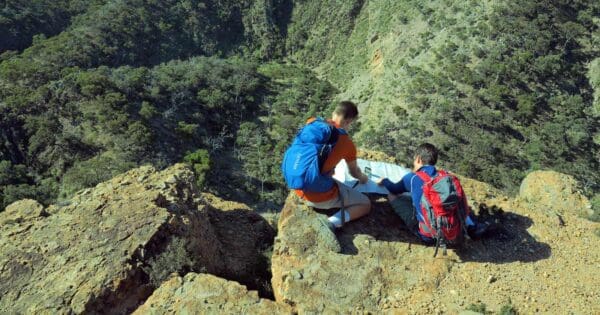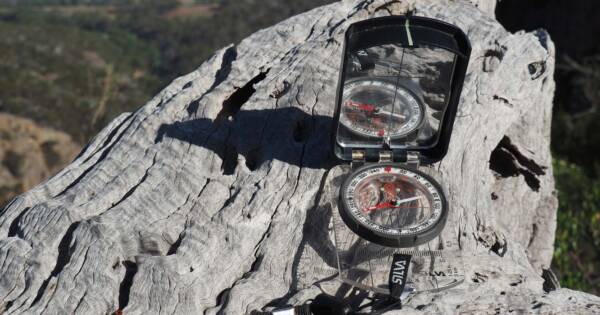Imagine summiting a distant peak, not with worry about getting lost, but with the exhilarating freedom that comes with choosing your adventure. You see a hidden trail snaking down a valley, untouched and inviting. The sun glints off a distant waterfall, whispering secrets beyond the marked path. From the rugged peaks of the Snowy Mountains to the windswept coastline of the Great Ocean Road, Australia’s wild beauty begs to be explored. But navigating Aussie terrain often throws unique challenges – unpredictable weather, diverse ecosystems, and vast remote areas. This is why hiking navigation matters. In this vastness, mastering navigation isn’t just about ticking off another peak; it’s about unlocking a world of possibilities, empowering you to safely wander off the beaten path, forge your own adventure, and truly connect with the soul of this land.
In this post, I’ll explore why hiking navigation matters for anyone heading outdoors for a walk in nature.
The Importance of navigation
Hiking the Aussie bush demands respect, especially when it comes to navigation. Unlike walking on well-marked and well-paved trails, navigating diverse terrain, unpredictable weather, and often remote locations of Australia’s backcountry requires more than just following a map. I’ve personally experienced the peace of mind and freedom that comes with confident navigation, knowing I can reach my destination safely and enjoy the stunning scenery without the worry of getting lost.
Beyond the thrill of exploration, knowing how to navigate is crucial for your safety. Getting lost in remote areas can have serious consequences, from dehydration and injury to exposure to harsh elements. Remember, responsible hiking starts with proper preparation, and mastering navigation skills is a key part of that.
Take the first step towards confident hiking adventures by learning more about navigation techniques. Check out my blog for detailed guides, explore reputable online resources, or consider joining a local hiking group with experienced navigators. Remember, every step towards mastering navigation is a step towards a safer and more enjoyable hiking experience.

What is navigation for hiking?
Navigation empowers you to confidently explore both designated trails and off-trail areas. It involves using maps, compasses, natural landmarks, and trail markings to stay on track, find your way back, and make informed decisions on the trail. Remember, navigation also includes understanding backup plans and basic survival skills for unexpected situations.
- Map Reading: Unlocking the secrets of the landscape starts with deciphering topographic maps. These intricate guides reveal hills, valleys, ridges, water sources, and potential hazards beyond marked trails. Learn to interpret contour lines, elevation scales, and map symbols to transform the map into a detailed guide. Study it before your hike, visualising your journey and anticipating challenges.
- Route Visualisation: Topographic maps go beyond mere start and end points. Before setting off, studying the map allows you to visualise the journey in depth. Discern river flows, identify valleys and ridges, anticipate climbs and descents, and locate natural landmarks. This mental preparation helps you understand the physical demands of the hike and make informed choices while navigating.
- Natural Landmarks: Observe natural features like rivers, ridges, or peaks as valuable reference points, especially when other tools are unavailable. Moss growing on south-facing slopes, stars aligning with mountain peaks, or distinct rock formations can all aid in orientation. Learn to recognise and utilise these natural clues.
- Trail Markings: Many trails display blazes, signs, emergency markers, or other indicators to guide your way. Following these markings not only keeps you on track but often provides crucial safety information. Familiarise yourself with different trail marking systems used in your region to accurately interpret their messages.
- Compass Use: Don’t underestimate the power of a compass for precise direction-finding and taking bearings, especially in areas with low visibility or unreliable maps. This vital tool unlocks the ability to navigate independently and confidently, even when the trail fades or technology fails. Remember, mastering compass skills requires dedicated learning and practice. Seek out detailed instructional courses or resources to understand compass techniques and how to utilise them for map orientation and accurate navigation.
- GPS Technology: GPS devices offer conveniences like real-time location tracking and route guidance, enhancing speed and group dynamics. However, treat them as supplemental tools, not replacements for traditional navigation skills. Battery depletion or signal loss can leave you reliant on alternative methods. Carry maps and a compass as backups and practice responsible GPS use.

The benefits of knowing how to navigate
Mastering navigation isn’t just about avoiding getting lost in the vast Aussie wilderness; it’s about unlocking a deeper, more confident, and enriching hiking experience. Imagine navigating unpredictable weather changes in the mountains with ease, confidently venturing off the beaten path to discover hidden waterfalls, or knowing you can handle unexpected detours with a smile. These are just some of the rewards that await skilled navigators in Australia’s diverse landscapes.
Beyond the thrill of exploration, here’s how mastering navigation fuels your hiking experience:
Empowerment & Confidence: Navigate unpredictable weather with ease, knowing you can find your way back. Venture off the beaten path with the skills to confidently explore hidden gems. Embrace unexpected detours with a smile, knowing you have the tools to handle them.
Deepen Your Connection with Nature: When you’re not worried about getting lost, you can truly immerse yourself in the beauty around you. Notice the vibrant wildflowers blooming off-trail, feel the exhilaration of reaching a secluded peak, and savor the peace of mind that comes from understanding your surroundings.
Unlock Diverse Landscapes: Don’t limit yourself to marked trails. With strong navigation skills, you can confidently explore remote areas, conquer challenging terrain, and discover hidden corners of the Australian wilderness that many hikers miss.
Safety First: Let’s not forget the most crucial benefit: peace of mind. Knowing how to navigate empowers you to stay safe on the trail, reducing the risk of getting lost, dehydrated, or injured. It’s an investment in your well-being and allows you to fully enjoy your adventure.
Remember, every step towards mastering navigation is a step towards unlocking a world of freedom, confidence, and unforgettable experiences in the Australian outdoors. Whether you’re a seasoned hiker or just starting out, investing in navigation skills is an investment in your safety, confidence, and connection with the Australian wilderness.
Start your journey to becoming a confident navigator by checking out my blog’s detailed guides, joining a local hiking group with experienced members, or taking a dedicated navigation course. Remember, every step towards mastering navigation is a step towards unlocking a world of rewarding adventures in the Australian outdoors.






I love navigation. Certainly gives you the freedom to explore.